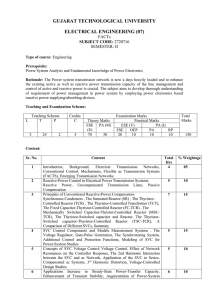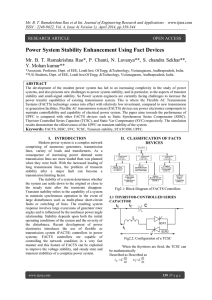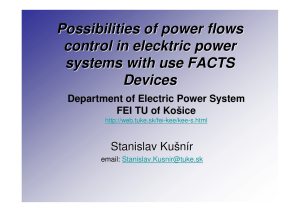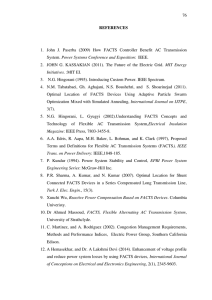A Comprehensive study of transient stability
advertisement
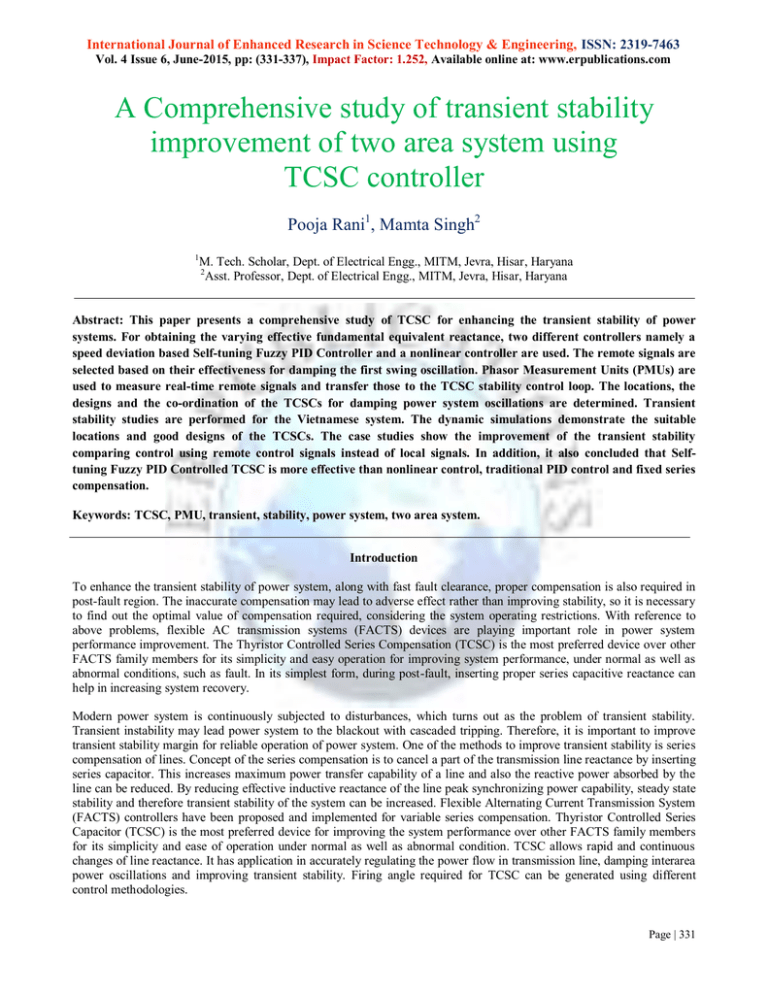
International Journal of Enhanced Research in Science Technology & Engineering, ISSN: 2319-7463 Vol. 4 Issue 6, June-2015, pp: (331-337), Impact Factor: 1.252, Available online at: www.erpublications.com A Comprehensive study of transient stability improvement of two area system using TCSC controller Pooja Rani1, Mamta Singh2 1 M. Tech. Scholar, Dept. of Electrical Engg., MITM, Jevra, Hisar, Haryana 2 Asst. Professor, Dept. of Electrical Engg., MITM, Jevra, Hisar, Haryana Abstract: This paper presents a comprehensive study of TCSC for enhancing the transient stability of power systems. For obtaining the varying effective fundamental equivalent reactance, two different controllers namely a speed deviation based Self-tuning Fuzzy PID Controller and a nonlinear controller are used. The remote signals are selected based on their effectiveness for damping the first swing oscillation. Phasor Measurement Units (PMUs) are used to measure real-time remote signals and transfer those to the TCSC stability control loop. The locations, the designs and the co-ordination of the TCSCs for damping power system oscillations are determined. Transient stability studies are performed for the Vietnamese system. The dynamic simulations demonstrate the suitable locations and good designs of the TCSCs. The case studies show the improvement of the transient stability comparing control using remote control signals instead of local signals. In addition, it also concluded that Selftuning Fuzzy PID Controlled TCSC is more effective than nonlinear control, traditional PID control and fixed series compensation. Keywords: TCSC, PMU, transient, stability, power system, two area system. Introduction To enhance the transient stability of power system, along with fast fault clearance, proper compensation is also required in post-fault region. The inaccurate compensation may lead to adverse effect rather than improving stability, so it is necessary to find out the optimal value of compensation required, considering the system operating restrictions. With reference to above problems, flexible AC transmission systems (FACTS) devices are playing important role in power system performance improvement. The Thyristor Controlled Series Compensation (TCSC) is the most preferred device over other FACTS family members for its simplicity and easy operation for improving system performance, under normal as well as abnormal conditions, such as fault. In its simplest form, during post-fault, inserting proper series capacitive reactance can help in increasing system recovery. Modern power system is continuously subjected to disturbances, which turns out as the problem of transient stability. Transient instability may lead power system to the blackout with cascaded tripping. Therefore, it is important to improve transient stability margin for reliable operation of power system. One of the methods to improve transient stability is series compensation of lines. Concept of the series compensation is to cancel a part of the transmission line reactance by inserting series capacitor. This increases maximum power transfer capability of a line and also the reactive power absorbed by the line can be reduced. By reducing effective inductive reactance of the line peak synchronizing power capability, steady state stability and therefore transient stability of the system can be increased. Flexible Alternating Current Transmission System (FACTS) controllers have been proposed and implemented for variable series compensation. Thyristor Controlled Series Capacitor (TCSC) is the most preferred device for improving the system performance over other FACTS family members for its simplicity and ease of operation under normal as well as abnormal condition. TCSC allows rapid and continuous changes of line reactance. It has application in accurately regulating the power flow in transmission line, damping interarea power oscillations and improving transient stability. Firing angle required for TCSC can be generated using different control methodologies. Page | 331 International Journal of Enhanced Research in Science Technology & Engineering, ISSN: 2319-7463 Vol. 4 Issue 6, June-2015, pp: (331-337), Impact Factor: 1.252, Available online at: www.erpublications.com Modern Power Transmission networks are becoming increasingly stressed due to growing demand and restrictions on building new lines. Losing stability is one of the major threats of such a stressed system following a disturbance. Flexible ac transmission system (FACTS) devices are found to be very effective in a transmission network for better utilization of its existing facilities without sacrificing the desired stability margin. Literature Review Transient stability is the one of the most important key factor during power transfer at high levels. According to the literature, transient stability of a power system is its ability to maintain synchronous operation of the machines when subjected to a large disturbance. While the generator excitation system can maintain excitation control but it is not adequate to sustain the stability of power system due to faults or overloading near to the generator terminals. Therefore researchers are working on this problem long time to find the solution. These solutions are such as using wide-area measurement signals, phasor measurement unit and flexible AC transmission system etc. A lot of research work has been carried out in series compensation. In 1966, Kimbark analyzed the improvement in transient stability of power system using switched series capacitors. In which maximum amount of compensation was inserted at the same time when the faulted line was switched out. Ramarao analyzed transient stability with optimal control using bang-bang control of line reactance. However, both methods were not able to provide the flexible adjustment of series capacitance. D. Pavh and R. Mihalic analyzed improvement in transient stability of line by means of controlled series compensation. Z. Xuequiang simulated TCSC on transmission line and observed that TCSC can improve dynamic performance of the power system. In this paper, first maximum swing of machine (δswing) and transient stability margin are calculated for different level of compensation for the evolution of transient stability. In the late 1980s, the Electric Power Research Institute (EPRI) formulated the vision of the Flexible AC Transmission Systems (FACTS) in which various power-electronics based controllers regulate power flow and transmission voltage and mitigate dynamic disturbances. Generally, the main objectives of FACTS are to increase the useable transmission capacity of lines and control power flow over designated transmission routes. Dr. M. Rajaram, et al. described the real and reactive power flow control through a transmission line by placing a FACT (UPFC) device at sending end of an electrical power transmission system. Matlab/Simulink shows the performance of UPFC. Power flow control performance of UPFC was compared with other FACTS devices like SVC, STATCOM and SSSC. Arun Kumar, et al. presented a detailed study on power system stability enhancement like frequency stability, rotor angle stability and voltage stability by using different FACTS controllers like SVC, TCSC, SSSC, STATCOM, UPFC and IPFC in an integrated power system networks. They conclude about the essential features of FACTS controllers and their potential to enhance the system stability. SamehKamel, et al. presents a report on modeling of the standard IEEE 14 bus system by using power system toolbox (PST) package. They described the basic fact about the system which was tested under small and large disturbances to improve the dynamic stability and stability margins. Results show a precise solution of increased stability margins when different FACTS controllers were added. FACTS controllers were modeled and tested to show the effect of these controllers on stability margins under both small and large disturbances. Salim Haddad, et al. presents a case study on modeling and interface of different FACTS devices in distributed power system by the use of Matlab. Simulation results investigate about the amount of active and reactive power flowing through transmission system. Results also depict the efficiency of FACTS devices in improving the stability of the power system. D. Murali, et al. presents the new challenges to power system stability and in particular transient stability and small signal stability for two area power system. They investigate the improvement of transient stability for two area power system with effective use of different types of FACTS controllers. The performance of UPFC was compared with different types of FACTS devices like Static Var Compensator, Static Synchronous Series Compensator, Thyristor controlled series compensator etc. Page | 332 International Journal of Enhanced Research in Science Technology & Engineering, ISSN: 2319-7463 Vol. 4 Issue 6, June-2015, pp: (331-337), Impact Factor: 1.252, Available online at: www.erpublications.com Anuradha S. Deshpande, et al. proposed a method of evaluating the first swing stability of a large power system in presence of FACTS devices. They considered FACT device and associated transmission line were represented by its equivalent pi circuit model. The model is then interfaced to the power network to obtain the system reduced admittance matrix which was used to generate the machine swing curves. The proposed method of generating dynamic response and evaluating first swing stability of a power system in the presence of FACTS device is tested on the three machine eleven bus sample test system. The results shows that the first swing of the generator gets reduced which further improves first swing stability. Sthitaprajna Rath, et al. presents a comprehensive review on the research and developments in power system stability enhancement using FACTS damping controllers. They discussed about the several technical issues that may create hindrance in FACTS devices installations. They conclude that with the use of FACTS controllers, maximum power can be transferred while maintaining dynamic stability and security. Vibhor Gupta described the study and effects of UPFC and its control system for power flow control and voltage injection in power system. He studied the operating modes of UPFC. Simulation is carried out in MATLAB and results indicate the use of power flow controller and voltage injection. He concludes about the benefits of using UPFC in the system. S. Javed Sajjadi, described the effects of series and shunt FACTS devices in transient stability enhancement of multimachine system. They described the injection model of unified power flow controller and series quadrature voltage injection. Results indicate that the shunt compensation was used for power oscillation damping and effects of series and shunt compensation on transient stability was discussed. N.K Sharma, et al. described the performance of UPFC in several modes operation using different control mechanism based on proportional plus integral control (PI) and Proportional plus integral plus derivative control (PID) . They also developed ANFIS based controller by using ANFIS editor of Matlab. The MATLAB simulation results indicate the capability of UPFC on power flow control and the effectiveness of controllers on the performance of UPFC in the different operating modes. M.A. Abido, presented a review on the research and developments in the power system stability enhancement using FACTS controllers. They thoroughly discussed about how FACTS devices were installed in the system to overcome the related issues which may arise during installation. Also a brief review of FACTS applications to optimal power flow was presented. Rahul Somalwar, et al. presented a review of enhancement of transient stability by FACTS devices. They also described about the coordination problem that likely to be occur among different control schemes. They investigate the system under fault conditions by using equal area criterion method. K. Venkateswarlu, et al.described the analysis and enhancement of transient stability using shunt controlled FACTS controllers. They briefly described that FACTS devices open up new opportunities for controlling power and enhancing the usable capacity in existing system. Results show the basic simulation of STATCOM for enhancing the transient stability of a two machine system using Matlab. The system was simulated under three phase fault condition and transient stability was predicted before and after the use of FACT device i.e. STATCOM. Thomas J. Overbye, et al. presented the use of FACTS devices for power system stability enhancement. They thoroughly describe the research on the development of new techniques for analysis and control of power systems using flexible AC transmission systems (FACTS) devices for both voltage and transient stability time frames. Results indicate that the FACTS devices are widely used to increase system stability margins by permitting control intervention during a system disturbance. Alok Kumar Mohanty, et al. described the power system stability improvement using FACTS devices. They briefly described about the challenges faced by modern power system under fault conditions and explained the need of FACTS devices to overcome these problems. In addition, they listed out the power system constraints and proposed the solutions to meet the power demand in future. They summarized about the semiconductor technology used in FACTS devices. S.Abazari, et al. proposed the transient stability improvement by using advanced static Var Compensator (SVC). They propose a new method for calculating the current references for an ASVC. The current references calculated are based on Transient energy function (TEF). Simulation was carried out with the help of C++ and Matlab Simulink. Results show a Page | 333 International Journal of Enhanced Research in Science Technology & Engineering, ISSN: 2319-7463 Vol. 4 Issue 6, June-2015, pp: (331-337), Impact Factor: 1.252, Available online at: www.erpublications.com comparison between optimal control and bang-bang control in an ASVC for improving transient stability in a multimachine system. Karim Sebaa, et al. presents the power system dynamic stability enhancement via coordinated design of PSS and SVC based controllers using hierarchical real coded NSGA-II. Results indicate the solution of tuning and location of minimum number of PSS and FACTS based controllers were proposed. S.V Ravi Kumar, et al. presents the transient stability using UPFC and SVC. They thoroughly described the damping of power system oscillations after a three phase fault and also analyze the effect of UPFC and SVC on transient stability performance of power system. They developed a general program for transient stability studies using modified portioned approach. The modelling of SVC and UPFC were studied and tested on a 10-generator, 39-bus, New England test generator. Results indicate that the SVC helps in improving the system performance by improving critical clearing time. Nasimul Islam Maruf, et al. presents a study on thyristor controlled series capacitor as a useful FACT device. They discussed the basic principle and benefits of TCSC during the fault conditions. They conclude that TCSC is a useful FACT device for enhancing the transient stability, steady state stability, dynamic stability and voltage stability of power system under severe conditions. Thyristor-Controlled Series Capacitor (TCSC) Many different techniques have been reported in the literature pertaining to investigating the effect of TCSC on power system stability. Several approaches based on modern control theory have been applied to TCSC controller design. Chen et al. presented a state feedback controller for TCSC by using a pole placement technique. However, the controller requires all system states which reduces its applicability. Chang and Chow developed a time optimal control strategy for the TCSC where a performance index of time was minimized. The impedance of the TCSC was adjusted based on machine rotor angle and the magnitude of the speed deviation. In addition, different control schemes for a TCSC were proposed such as variable structure controller bilinear generalized predictive controller, and H∞-based controller. The neural networks have been proposed for TCSC-based stabilizer design. The parameters of the stabilizers are determined by genetic algorithm (GA). The damping characteristics of the designed stabilizers have been demonstrated through simulation results on a multimachine power system. Wang et al. presented a robust nonlinear coordinated control approach to excitation and TCSC for transient stability enhancement. The excitation controller and TCSC controller have been designed separately using a direct feedback linearization technique. Lee and Moon presented a hybrid linearization method in which the algebraic and the numerical linearization technique were combined. TCSC Control Scheme A conventional stability control scheme for TCSC is shown in Fig. 1. It includes two main operational blocks as an external control and an internal control. The function of the external control is to operate the controller to accomplish specified compensation objectives. Measured systems variables are used to define the reference for the internal control, which is usually the value of the controller reactance. The function of the internal control is to provide appropriate gate drive signals for the thyristor valves Effectiveness of TCSC Controllers Using Remote Input Signals for Transient Stability Enhancement to produce the desired compensating reactance. Thus, the external control is the one that defines the functional operation of the controller. In Fig. 1, Xm is the stability control modulation reactance value from the stability or dynamic control loop. The sum of these two values yields ' X m , which is the final value of the reactance ordered by the external control block. The desired magnitude of the TCSC reactance, Xe, is obtained after a finite delay caused by the firing controls and the natural response of the TCSC. This delay is modelled by a lag circuit having a time constant, T, of typically 15-20 ms. The output of the firstorder lag is subject to variable limits based on the TCSC reactance-capability characteristic. The stability control loop is a pre-programmed open-loop control which is used to improve transient (or first swing) stability. When the system is subjected to a severe transient disturbance such as a fault on transmission facilities, loss of generation, or loss of a large load, the stability control loop acts initially, leading to the maximum compensation level during a certain time, so that the synchronizing torque is increased, improving the first-swing stability response of the system. The control then provides proper modulation to damp the subsequent power oscillations. There are many studies on the damping control of TCSC based on a transfer function based linear control with a local input signal. However, this linear control is usually designed for a specific operating point and condition. They are effective at damping the oscillation under the design conditions. Page | 334 International Journal of Enhanced Research in Science Technology & Engineering, ISSN: 2319-7463 Vol. 4 Issue 6, June-2015, pp: (331-337), Impact Factor: 1.252, Available online at: www.erpublications.com Fig. 1: TCSC model for stability studies The general structure of the stability controller is depicted in Fig. 2. It consists of a washout filter, a dynamic compensator, and a limiter. The washout filter is mainly provided to avoid the controller response to the dc offset of the input signal. The dynamic compensator consists of one or more lead-lag blocks to provide the necessary phase-lag characteristics. Finally, the limiter is used to improve controller response to large deviations in the input signal. Fig. 2: Block diagram of conventional stability control of TCSC Transient Stability Studies using TCSC The ability of a synchronous power system to return to stable condition and maintain its synchronism following a relatively large disturbance arising from very general situations like switching ‘on’ and ‘off’ of circuit elements, or clearing of faults etc. is referred to as the transient stability in power system. More often than not, the power generation systems are subjected to faults of this kind, and hence its extremely important for power engineers to be well-versed with the stability conditions of the system. Transient stability assessment (TSA) is part of dynamic security assessment of power systems which involves the evaluation of the ability of a power system to maintain synchronism under severe but credible contingencies. Methods normally employed to assess TSA are by using time domain simulation, direct and artificial intelligence methods. Time domain simulation and direct methods are considered most accurate but are time consuming and need heavy computational effort. Transient Stability involves the study of the power system following a major disturbance. Following a large disturbance the synchronous alternator the machine power (load) angle changes due to sudden acceleration of the rotor shaft. The objective of the transient stability study is to ascertain whether the load angle returns to a steady value following the clearance of the disturbance. The ability of a power system to maintain stability under continuous small disturbances is investigated under the name of Dynamic Stability (also known as small-signal stability). These small disturbances occur due random fluctuations in loads Page | 335 International Journal of Enhanced Research in Science Technology & Engineering, ISSN: 2319-7463 Vol. 4 Issue 6, June-2015, pp: (331-337), Impact Factor: 1.252, Available online at: www.erpublications.com and generation levels. In an interconnected power system, these random variations can lead catastrophic failure as this may force the rotor angle to increase steadily. For transient stability analysis we need to consider three systems: Prefault - before the fault occurs the system is assumed to be at an equilibrium point Faulted - the fault changes the system equations, moving the system away from its equilibrium point Postfault - after fault is cleared the system hopefully returns to a new operating point The general block diagram of the TCSC model and external control structure used in this work is shown in Fig. 1. In this figure, Xm is the stability control modulation reactance value, as determined by the stability or dynamic control loop, and Xeo denotes the TCSC steady state reactance or set point, whose value is provided by the power flow or steady state control loop. The sum of these two values yields X’m, which is the final value of the reactance ordered by the external control block. This signal is put through a first-order lag to represent the natural response of the device and the delay introduced by the internal control, which yields the equivalent capacitive reactance Xe of the TCSC. This model is valid for dynamic and steady state stability analyses, i.e. for balanced, fundamental frequency system conditions. A TCSC model suitable for voltage and angle stability applications and power flows studies is discussed. In that model, the equivalent impedance Xe of the device is represented as a function of the firing angle α, based on the assumption of a sinusoidal steady-state controller current. In this model, it is possible to directly represent some of the actual TCSC internal control blocks associated with the firing angle control, as opposed to just modeling them with a first order lag function. Conclusions In this review, the power system stability enhancement using TCSC controller was discussed. The essential features of TCSC controllers and their potential to enhance system stability was addressed. The location and feedback signals used for design of TCSC-based damping controllers were discussed. The coordination problem among different control schemes was also considered. Performance comparison of different FACTS controllers has been reviewed. It is observed that the controller is very effective and ensures guaranteed stability. The paper has given a different view point of flatness and have developed a flatness-based feedback linearization and shown its application in designing of TCSC controller using RHC principle. The major contribution of paper is in terms of application of TCSC concept for power system transient stability problems. References [1]. [2]. [3]. [4]. [5]. A. [6]. [7]. [8]. [9]. [10]. [11]. [12]. [13]. H. M. A. Rahim and S. G. A. Nassimi, “Synchronous Generator Damping Enhancement through Coordinated Control of Exciter and SVC”, IEE Proc. Genet. Transm. Distrib., 143(2)(1996), pp. 211–218. N. G. Hingorani and L. Gyugyi, Understanding FACTS: Concepts and Technology of Flexible AC Transmission Systems. New York: IEEE Press, 2000. N. G. Hingorani, “FACTS-Flexible AC Transmission System”, Proceedings of 5th International Conference on AC and DC Power Transmission-IEE Conference Publication 345, 1991, pp. 1–7. N. G. Hingorani, “Flexible AC Transmission”, IEEE Spectrum, April 1993, pp. 40–45. N. G. Hingorani, “High Power Electronics and Flexible AC Transmission System”, IEEE Power Engineering Review, July 1988. Edris et al., “Proposed Terms and Definitions for Flexible AC Transmission System (FACTS)”, IEEE Trans. Power Delivery, 12(4)(1997), pp. 1848–1852. IEEE Power Engineering Society, FACTS Overview. IEEE Special Publication 95TP108, 1995. V. Rajkumar and R. Mohler, “Bilinear Generalized Predictive Control Using the Thyristor Controlled Series Capacitor”, IEEE Trans. PWRS, 9(4)(1994), pp. 1987–1993. Q. Zhao and J. Jiang, “A TCSC Damping Controller Using Robust Control Theory”, Int. J. of Electrical Power & Energy Systems, 20(1)(1998), pp. 25–33. X. Dai, J. Liu, Y. Tang, N. Li, and H. Chen, “Neural Network αth-Order Inverse Control of Thyristor Controlled Series Compensator”, Electric Power Systems Research, 45(1998), pp. 19–27. T. Senjyu, S. Yamane, Y. Morishima, K. Uezato, and H. Fujita, “Improvement of Multimachine Power System Stability with Variable Series Capacitor Using On-Line Learning Neural Network”, Int. J. Electrical Power & Energy Systems, 25(3)(2003), pp. 403–409. Y. Wang, Y. Tan, and G. Guo, “Robust Nonlinear Coordinated Excitation and TCSC Control for Power Systems”, IEE Proc.Gener. Transmi. Distib., 149(3)(2002), pp. 367–372. Zhao Xueqiang, “Study of TCSC Model and Perspective Application in Power System of China,” IEEE 1999 International Conference on Power Electronics and Drives System, PEDS‟99, Hong Kong, July 1999. Page | 336 International Journal of Enhanced Research in Science Technology & Engineering, ISSN: 2319-7463 Vol. 4 Issue 6, June-2015, pp: (331-337), Impact Factor: 1.252, Available online at: www.erpublications.com [14]. Dolan. P.S., Smith, J.R., and Mittelstadt, W.A.: A study of TCSC optimal damping control parameters for different operating conditions‟, IEEE Trans. Power Syst., 1995, 10, pp. 1972-1978. [15]. Venkateswarlu, K. and Babu, C. S,. (2011, May). Analysis and Enhancement of Transient Stability using SHUNT Controlled FACTS Controllers. International Journal of Engineering Sciences Research. 1(2). [16]. Overbye, T. J., & Brown, D. (1993, August). Use of FACTS devices for power system stability enhancement. In Circuits and Systems, 1993. Proceedings of the 36th Midwest Symposium on (pp. 1019-1022). IEEE. [17]. Mohanty, A. K., &Barik, A. K. (2011). Power System Stability Improvement Using FACTS Devices. International Journal of Modern Engineering Research, 1(2), 666-672. [18]. ABAZARI, & EMADI. (2003). Transient stability improvement by using advanced static VAR compensators. Electric Power Components and Systems, 31(4), 321-334. [19]. M. H. Haque,"Improvement of first swing stability limit by utilizing full benefit of shunt facts devices", IEEE Trans. Power Syst., vol. 19, no. 4, pp.1894 - 1902, 2004. [20]. D. P. Kothari, I. J. Nagrath, "Modern Power System Analysis",India: Tata McGraw-Hill Publishing Company Limited, 2003. pp.433-510. [21]. E. W. Kimbark, ”Improvement of System Stability by Switched Series Capacitors,” Power Apparatus and Systems, IEEE Transactions on, vol. PAS-85, pp. 180-188, 1966. [22]. “Impact of Interactions Among System Controllers,” CIGRE Task Force 38.02.16, November 1999. [23]. G. Hingorani and L. Gyugyi, Understanding FACTS: Concepts and Technology of Flexible AC Transmission Systems, IEEE Press, 1999. [24]. A. Cañizares and Z. T. Faur, “Analysis of SVC and TCSC Controllers in Voltage Collapse ,” IEEE Trans. Power Systems, Vol. 14, No. 1, February 1999, pp. 158-165. [25]. L.S. Moulin, A.P.A. da Silva, M.A. El-Sharkawi, R.J. Marks, “Support vector and multilayer perceptron neural networks applied to power systems transient stability analysis with input dimensionality reduction,” IEEE PES Summer Meeting, vol. 3, pp. 1308 – 1313, July 2002. [26]. Nagu B, RamanaRao PV, Sydulu M , Kumar Alok "Versatile PID-HVDC Controls for Enhancement of Power System Stability", J.E.E, Volume 13/2013, edition 2,N° 60. [27]. E. Leung: Surge protection for power grids, IEEE spectrum, pp.26-30, 1997. [28]. John J. Grainger, William D. Stevenson,JR. “ Power System Analysis”. McGraw-Hill, 1994. Page | 337

